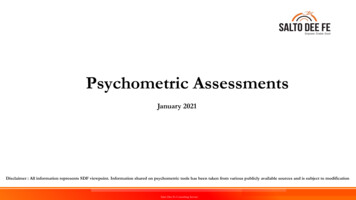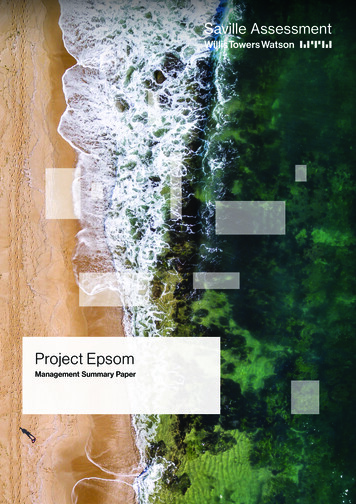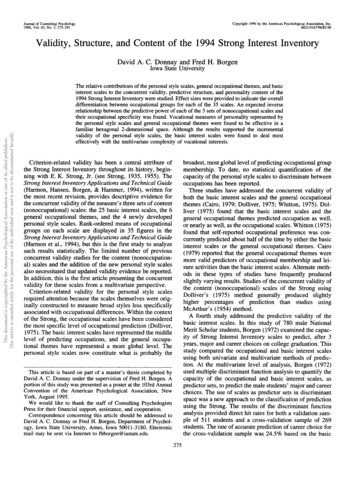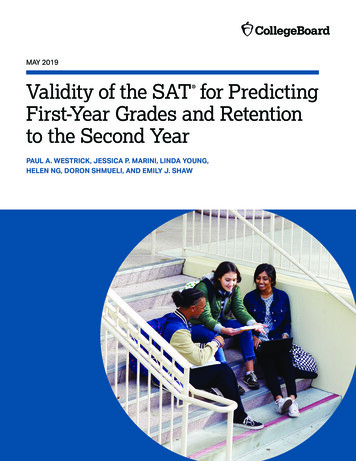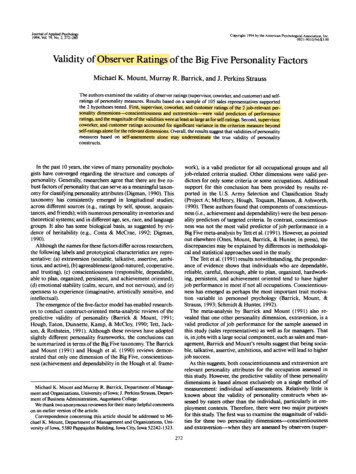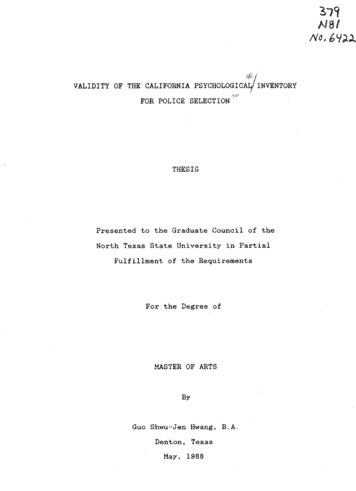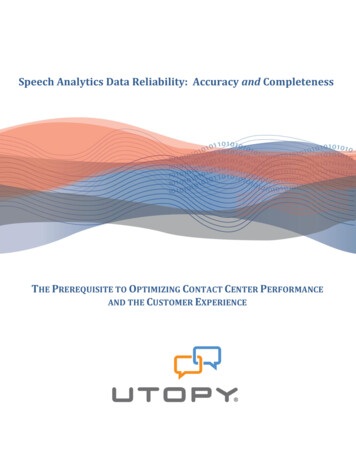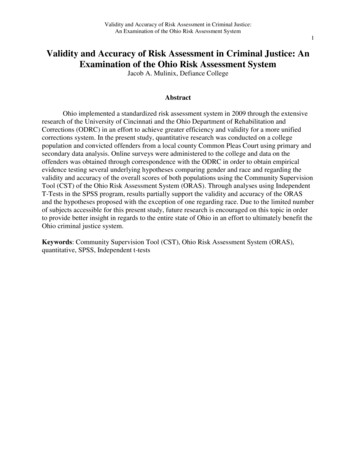
Transcription
Validity and Accuracy of Risk Assessment in Criminal Justice:An Examination of the Ohio Risk Assessment System1Validity and Accuracy of Risk Assessment in Criminal Justice: AnExamination of the Ohio Risk Assessment SystemJacob A. Mulinix, Defiance CollegeAbstractOhio implemented a standardized risk assessment system in 2009 through the extensiveresearch of the University of Cincinnati and the Ohio Department of Rehabilitation andCorrections (ODRC) in an effort to achieve greater efficiency and validity for a more unifiedcorrections system. In the present study, quantitative research was conducted on a collegepopulation and convicted offenders from a local county Common Pleas Court using primary andsecondary data analysis. Online surveys were administered to the college and data on theoffenders was obtained through correspondence with the ODRC in order to obtain empiricalevidence testing several underlying hypotheses comparing gender and race and regarding thevalidity and accuracy of the overall scores of both populations using the Community SupervisionTool (CST) of the Ohio Risk Assessment System (ORAS). Through analyses using IndependentT-Tests in the SPSS program, results partially support the validity and accuracy of the ORASand the hypotheses proposed with the exception of one regarding race. Due to the limited numberof subjects accessible for this present study, future research is encouraged on this topic in orderto provide better insight in regards to the entire state of Ohio in an effort to ultimately benefit theOhio criminal justice system.Keywords: Community Supervision Tool (CST), Ohio Risk Assessment System (ORAS),quantitative, SPSS, Independent t-tests
Validity and Accuracy of Risk Assessment in Criminal Justice:An Examination of the Ohio Risk Assessment System2IntroductionDelinquency and crime has, unfortunately, remained a significant problem for the justicesystem and social services across the nation. Several factors have been examined throughextensive research by numerous institutions and independent researchers over the years, showingcorrelations between family structure, religious affiliation and deviant behavior. Manyresearchers have made use of the social control theory and the National Longitudinal Study, andseveral of those studies found that single-parent homes and households consisting of no fatherfigure had the highest risk for deviant behavior later in life (Antecol & Bedard, 2002;Francesconi, 2001).Many people blame the issue of crime on peer pressure, while others blame it on mentalhealth disorders or the way an individual was raised. In reality, there really is no concrete factorthat plays into the reason of why people become criminals. In 2006, the Ohio Department ofRehabilitation and Corrections (ODRC) contracted with the University of Cincinnati, Center forCriminal Justice Research, in an effort to solve those problems. The Ohio Risk AssessmentSystem was developed as “a risk and needs assessment system that improved consistency andfacilitated communication across criminal justice agencies” (Latessa et al., 2009, pg. 1).The interest of this study is to anonymously gather data concerning individuals fromvarious demographics and to correlate that information with self-reported risk assessments. Thepurpose is to determine the validity and accuracy of the Ohio Risk Assessment System bycomparing the risk scores of convicted offenders from a local county Common Pleas Court to therisk scores of respondents at a local college. An extensive literature review that delved into thecurrent issue was performed, and the research was supported by the theories expressed in thesocial control theory. The researcher provided surveys to various individuals at the college andobtained a secondary data analysis of test scores of convicted offenders of the county CommonPleas Court that were assessed using the Ohio Risk Assessment System. The college respondentstook the survey online using Qualtrics, which provided an output file which was compatible withthe SPSS program. The information obtained from the county offenders was also uploaded intothe SPSS program for further analysis. General demographic information was obtained throughthe use of the descriptives analysis on the SPSS program. A series of Independent T-Tests wereperformed on the data comparing means of both populations in regards to gender and race.Results can be viewed in further detail in the results section and in Appendix B.As a community corrections professional, this researcher is aware that most offendershave more than one underlying risk factor. Some may be victims of abuse, while others mayhave substance abuse issues in their lives or poor education. Others may struggle withmaintaining a job or with decision-making. Due to these various issues, the state of Ohio hasdeveloped a risk assessment system for the purpose of identifying risk in offenders to better beable to supervise them. The following literature review will go into greater detail about this riskassessment system and will discuss the current issues that the corrections system is facing today.There are seven hypotheses in this study regarding the mean ORAS score of offenders incomparison to College respondents, and also when factoring in gender and race. The developersof the ORAS instrument recommended that further testing of validity be done, which is exactlywhat this study will be doing.Results partially support the validity and accuracy of the Ohio Risk Assessment System,but there are several concerns to address in the future beyond the scope of this study. Most of thehypotheses were supported, with the exception of one regarding race, which will be discussedfurther in a later part of this paper. The ORAS is fairly new to the Ohio criminal justice system
Validity and Accuracy of Risk Assessment in Criminal Justice:An Examination of the Ohio Risk Assessment System3and has been subjected to many jurisdictions over the past several months in an effort to fullyimplement the system in the state of Ohio. Below are a discussion of the ORAS and an overviewof the development and purpose of this instrument.Review of LiteratureResearchers in the past and present have been diligently working to find a way tounderstand risk and what factors actually cause criminal offending, whether it is social or naturalcharacteristics. A lot of research has been done in the past in regards to what causes criminaloffending, but now there seems to be a growing trend in the social research field for studiesfocusing on offender risk and recidivism. In the state of Ohio, the current risk assessment toolused by the justice system is the Ohio Risk Assessment System (ORAS), which was created byresearchers at the University of Cincinnati in conjunction with the Ohio Department ofRehabilitation and Corrections from 2006 to 2009 and was fully implemented in most probationdepartments in the state of Ohio by October of 2011. The ORAS tool was created in an effort tobetter assess the risk of offenders in the state of Ohio. The assessment system is designed toprotect public safety and guide the corrections system on how to supervise offenders at any risklevel (Latessa et al., 2009).In the public's eye, any offender of any sort is considered to be a threat. In reality, thereare many factors to consider in making someone an actual threat to society. An offender mayhave a substantial substance abuse history, but may have never been violent in their past and maybe well educated otherwise. This is where the risk assessment tools are important. In order todetermine just how much of a risk a person is to society, community corrections professionalsmust perform assessments (Latessa, 2003-2004; Latessa & Lowenkamp, 2005b). Communitycorrections professionals are extensively trained on how to perform assessments and must becertified through the Ohio Department of Rehabilitation and Correction in order to assessoffenders. The complexity of these assessment tools should ensure that the results will beaccurate and reliable.Latessa outlined the four principles of effective classification as: the risk principle, theneeds principle, the responsivity principle, and the professional discretion principle (as cited inAndrews, Bonta, & Hoge, 1990). Contemporary risk assessment tools are designed to measurethe risks and needs of offenders, as well as static and dynamic factors that affect the offender’sability to be successfully rehabilitated and reintegrated into society (Latessa 2003-2004; Latessa& Lowenkamp, 2005a). Latessa and the rest of the research group identified three major goals inthe development of the ORAS tool, including “1) separated Ohio offenders into risk groupsbased on their likelihood to recidivate, 2) identified dynamic risk factors that can be used toprioritize programmatic needs, and 3) identify potential barriers to treatment (Latessa et al.,2009, pg. ii; Latessa et al., 2010). Using the ORAS tool, professionals are able to determine whatlevel of risk an offender should be categorized as based on their overall score at the end of theassessment. Risk levels vary from low to high, with several levels in between. These scores canbe used in order to determine how an offender should be supervised and what treatmentprograms they should be subjected to (Latessa et al., 2009). Below is the chart that is used tocategorize offenders according to their total ORAS score using the Community Supervision Tool(ORAS-CST).
Validity and Accuracy of Risk Assessment in Criminal Justice:An Examination of the Ohio Risk Assessment System4(Latessa et al., 2009, pg. 50)To clarify, a male offender that scores from 0 through 14 will be considered a low riskoffender, from 15 to 23 will be considered moderate risk, from 24 to 33 will be a high risk andfrom 34 or higher (49) will be a very high risk. For females, an offender that scores from 0through 14 will be considered a low risk offender, from 15 to 21 will be considered moderaterisk, from 22 to 28 will be a high risk and from 29 or higher (49) will be a very high risk. Thechart above provides the percent of likelihood that an offender will fail or recidivate while onsupervision with respect to each risk level. According to the ORAS tool, offenders in the low riskcategory should have little to no programming, while moderate and high risk offenders should beplaced into the intensive supervision programs. The CST of the ORAS consists of a total of 35individual questions within 7 sections and has potential scores ranging from 0 to 49 (Latessa etal., 2009).The scores are also used by community corrections centers, jails and prisons. Someoffenders may go through a series of up to three or four assessments over a period of timedepending on the decisions made in court. There are a total of five assessment instruments withinthe Ohio Risk Assessment System, including The Pretrial Assessment Tool, The CommunitySupervision Tool, the Community Supervision Screening Tool, The Prison Intake Tool, and theReentry Tool (Latessa et al., 2009). These tools provided pure gold evidence through quantitativeresearch that is used to identify dynamic risk factors and potential barriers to treatment(Andrews, Bonta, & Hoge, 1990; Bonta, 2002). In Latessa’s final report published in 2009, hedefined dynamic risk factors, or criminogenic needs, as “factors that when changed, have beenshown to result in a reduction in recidivism” (Latessa et al., 2009, pg. 2). Several of these riskfactors are examined throughout the CST in the Ohio Risk Assessment System.An offender may be assessed by a probation officer or an intake officer at a communitybased correctional facility (CBCF), jail or prison (Holsinger, Lurigio, & Latessa, 2001). Thestatic factors will remain unchanged no matter how many times the assessment is done, but thedynamic factors allow the supervising authority to determine the success of the treatment andprogramming the offender has been subjected to over the term of their supervision (Latessa2003-2004).Officer discretion can be used throughout the assessment process, but overall there is aset of guidelines to follow when performing the tests. The guidelines are spelled out for theassessment administrator in order to improve the reliability of the decisions made in regards tooffender treatment and to set a precedent for all offenders across the system (Latessa, 20032004). Researchers in the past, namely those directly involved in the development of the ORAStool, admit that professional discretion is important because of the limitations of assessmentinstruments (Holsinger, Lurigio, & Latessa, 2001; Latessa et al., 2009; Latessa et al., 2010). It isimportant that offenders be placed into an appropriate treatment program according to their levelof risk in order to avoid unnecessary and unforeseen complications in the future.Research has shown that placing a low risk offender into an intensive program actuallyachieves negative results and causes that offender to recidivate when they were not as likely to ifthey would have been treated according to the risk level. Most prisons currently use similar
Validity and Accuracy of Risk Assessment in Criminal Justice:An Examination of the Ohio Risk Assessment System5assessments when they are placing offenders in cellblocks. It would be unnecessary for a lowrisk offender to be placed into a maximum security cell block, just as it would be unnecessary toplace a low-risk offender into an intensive supervision program. When low-risk offenders aresubjected to intensive treatment programs, they are more likely to be exposed to offenders ofhigher risk categories, which could disrupt prosocial networks that aid in the prevention ofrecidivism (Andrews, Bonta, & Hoge, 1990; Latessa, 2003-2004; Lowenkamp & Latessa, 2004b;Lowenkamp & Latessa, 2005b). Misplacing offenders in inappropriate programming can lead tofurther problems in the future and is essentially a waste of resources due to the increased risk thathas now been manifested (Lowenkamp & Latessa, 2003; Lowenkamp & Latessa, 2004a).Bonta (2002) also discusses the issue of validity in regards to the ORAS. He stated thatthe assessment tools should be able to predict criminal activity and should be directly relevant tocriminal behavior. He emphasized the importance of assessing several dynamic factors in orderto identify the best treatment and supervision program for the offender. In order for theassessment instruments to be effective, Bonta (2002) encouraged that they should be based onrelevant theories of human behavior, such as sociological-criminological explanations of crime,psychopathological models, or social learning perspectives (Bonta, 2002).In the past, there have been several pre-existing risk assessment tools developed. Most ofthese tools were not valid predictors for certain populations and were not as diverse as the ORAS(Latessa et al., 2010). Some of these tools also failed to quantitatively distinguish between risklevels which made it difficult to predict the likelihood of recidivism and the need for treatment(Latessa & Lowenkamp, 2005a).On the contrary, there has also been some very successful and valid assessment toolsproduced throughout the United States. The most common is the Level of Service InventoryRevised (LSI-R), which is based directly off of the social learning theory. This instrument has 54items, in comparison to the 35 items on the CST of the ORAS, and 10 sections, in comparison tothe seven sections on the CST of the ORAS. The LSI-R has many of the same questions as theCST, but goes into more depth on some of the categories. According to Latessa (2003-2004), theLSI-R has been determined to be one of the most valid instruments in predicting recidivism foroffenders. Another well-known assessment tool is the Statistical Information on Recidivism(SIR), which is very similar to the CST as well, but has five categories of risk rather than four.According to Latessa (2003-2004), the SIR was revalidated by Bonta, Harman, Hann, andCormier in 1996 (Latessa, 2003-2004).This researcher would agree with Latessa and Lowenkamp (2005a) that assessmentshould be thought of as an ongoing process. The state of Ohio identified the need for aninstrument that followed offenders throughout the entire criminal justice system and was relevantat all points in the process, which prompted the development of the ORAS. A research team fromthe University of Cincinnati studied a population of 1,839 Ohio offenders through surveys andinterviews and developed a database of over 200 potential risk factors, which were eventuallynarrowed down to the 35 items that are now focused on in the CST and other tools of the ORAS(Latessa et al., 2009; Latessa et al., 2010). Offenders are categorized based on their overall scorein regards to risk, but can also be assessed in each of the seven individual categories in order fortheir supervising officer to prioritize treatment accordingly (Latessa et al., 2010).The importance of this standardized instrument for the entire state of Ohio is very high.The Ohio Department of Rehabilitation and Corrections, along with the University of Cincinnati,spent several years researching, studying and validating this assessment system, and it isbelieved to be valid and accurate in assessing risk levels (Latessa et al., 2009; Latessa et al.,
Validity and Accuracy of Risk Assessment in Criminal Justice:An Examination of the Ohio Risk Assessment System62010). However, in 2010, Latessa published an article addressing the limitations of the study inregards to the relevancy of the assessment system to all jurisdictions in the state of Ohio, butargued that based on the number and diversity of participants that the results are still encouraging(Latessa et al., 2010). For the purpose of this study, the following theory section will discuss therelevance of the validity theory to the topic at hand.TheoryAs stated above, the purpose of this study is to test the validity and accuracy of the OhioRisk Assessment System. Sireci indicated that since the early 1950s, the American PsychologicalAssociation has provided standards for testing validity (as cited in APA, 1954). Continuousresearch has been done over the years in order to maintain those standards. Several studies andarticles were reviewed on this topic, ranging from the early 1950s to the most recent in 2007 byStephen G. Sireci, who stated “To prove our worth in the world, we as researchers must presentevidence that the information provided by the tests that we study and help create is useful andscientifically sound” (Sireci, 2007, pg. 477). With the purpose of this study in mind, it isimportant to remember the difficulty in proving the validity of the test and the ability todetermine if the test is measuring what it is designed for. According to Sireci (1998a, 2007),Messick (1989b), Kane (1992, 2006), and several others, conclusions were made that it isessentially impossible to prove the validity of a test and the relevancy of its measurements(Sireci, 2007).Since the 1950s, there have been a total of five versions of the standards created by theAmerican Psychological Association. Sireci (2007) listed four major points to summarize thevalidity theory, including:“Validity is not a property of a test. Rather, it refers to the use of a test for aparticular purpose.To evaluate the utility and appropriateness of a test for a particular purposerequires multiple sources of evidence.If the use of a test is to be defensible for a particular purpose, sufficient evidencemust be put forward to defend the use of the test for that purpose.Evaluating test validity is not a static, one-time event; it is a continuous process;”(as cited in Cronbach, 1971; Kane, 1992; Messick, 1989a, 1989b; Shepard, 1993;AERA et al., 1999) (Sireci, 2007, pg. 477).There have been some suggested modifications to the validity theory over the years,including when Ebel (1961) suggested using the term meaningfulness instead of validity, andwhen Kane (1992) proposed a new approach to the validation methodology, and when Lissitzand Samuelsen (2007) suggested a change in the terminology again with an emphasis oneducational validity approaches (Ebel, 1961; Kane, 1992; Lissitz & Samuelsen, 2007; Sireci,2007). The AERA takes several of these inquiries into account and several changes have beenmade over the years, which have led up to the current definition of validity as “the degree towhich evidence and theory support the interpretations of test scores entailed by proposed uses oftests” (AERA et al., 1999, p. 9).The current standards have five sources of validity evidence that are used in the processof validating a tool, including: “(a) test content, (b) response processes, (c) internal structure, (d)relations to other variables, and (e) consequences of testing (AERA et al., 1999, p. 11). The
Validity and Accuracy of Risk Assessment in Criminal Justice:An Examination of the Ohio Risk Assessment System7purpose of having the five steps is to allow for the evaluation of all aspects of a test up to andincluding any attached theory, construct and test (Sireci, 2007).There are advantages and disadvantages of the validity theory. One major advantage isthat the theory ensures that tests will be accurate and with purpose, rather than being spontaneousand useless. The theory, however, can be confusing to the average layperson and can be anextensive process. Lissitz and Samuelsen (2007) and Sireci (1998a, 2007) argued that thevalidation process has been impeded due to the focus on construct validity, rather than testpurpose (Lissitz & Samuelsen, 2007; Sireci, 2007). Sireci (2007) stated that the validationinvestigation should “involve both subjective analysis of test content and empirical analysis oftest score and item response data” (Sireci, 2007, pg. 481). This researcher would agree withSireci (2007) in questioning how a test can be validated if the committee does not know thepurpose of the test.In order to validate a tool or test, there must be a clear understanding of the purpose ofthe test scores in the theory behind the purpose. To elaborate further, Sireci indicated that theStandards described, “A sound validity argument integrates various strands of evidence into acoherent account of the degree to which existing evidence and theory support the intendedinterpretation of test scores for specific uses. . . . Ultimately, the validity of an intendedinterpretation . . . relies on all the available evidence relevant to the technical quality of a testingsystem. This includes evidence of careful test construction; adequate score reliability;appropriate test administration and scoring; accurate score scaling, equating, and standardsetting; and careful attention to fairness for all examinees” (AERA et al., 1999, p. 17; Sireci,2007, pg. 479).Sireci agrees, and this researcher concurs, that evaluation of testing consequences isnecessary. Messick (1989b) and Sireci (2007) discussed how unintended negative consequencesmay indicate problems within a testing system. This issue could be a major concern with regardsto the Ohio Risk Assessment System due to the seriousness of the consequences that could arise,such as loss of freedom or inappropriate treatment programming and supervision. Due to the riskof unintended negative consequences, this research is aimed at determining the validity of theORAS in order to optimistically avoid future conflicts should issues arise in the duration of thisproject.MethodThe following research is quantitative, but the primary method used is deduction.Deduction occurs when hypotheses are derived from extant literature. Quantitative analysisinvolves the analysis of data using numerical values in order to draw certain conclusions(Babbie, 2011). Two different kinds of data are presented in this study. Primary data wascollected by the researcher via an online survey through Qualtrics. The primary data werecomposed of college respondents. A secondary data source, county convicted offenderinformation, was provided by the research bureau of the Ohio Department of Rehabilitation andCorrections. There is no reason to believe that the secondary data provided by the state wouldhave been any different had the researcher collected it himself.A series of requests and permissions were required in order to perform the currentresearch. The researcher began requesting for permissions and consents to release informationwith the county Common Pleas Court. A Consent to Release Information form was signed by thepresiding judge. Approval from the college Institutional Review Board (IRB) committee wasobtained.
Validity and Accuracy of Risk Assessment in Criminal Justice:An Examination of the Ohio Risk Assessment System8SampleThe question arose of whether or not the county selected is a good representative of thestate of Ohio in regards to demographic breakdown. The 2011 estimated population of the40,860.69 mi.² land area of the state of Ohio was 11,544,951 people, consisting of 51.2% female,81% white, 12.4% black and 3.2% Hispanic. The 2011 estimated population of the 411.46 mi.²land area of the county was 39,035 people, consisting of 50.7% female, 87.8% white, 2.1% blackand 8.8% Hispanic. The county has a slightly older population, with a lower percentage ofminorities, a lower percentage with post high school education, and a lower median householdincome in comparison to the entire state of Ohio.In comparison to the college student population, nearly 22.4% of the total population iscounty residents. There are a total of 932 undergraduates and 89 graduates enrolled, but a total of1,090 received the online survey request, along with the 216 faculty members and 162 staffmembers. Of the total number of students enrolled, 781 were Ohio residents, which accounts for76.5% of the overall student population. There were 230 non-Ohio residents and 10 internationalstudents. In regards to gender, there were 500 males and 621 females. In regards to race, therewere 205 (20.1%) minorities and 816 (79.9%) non-minorities (white/Caucasian). There were atotal of 61 Ohio counties represented at the college.The sample was planned to consist of at least 200 individuals, including 100 respondentsfrom a local college and 100 randomly selected offenders from the local county Common PleasCourt. The college was chosen as part of the representative population due to the diversity oncampus and the amount of potential respondents to participate in the study. The offenders from alocal county were selected due to the availability of the information and the diversity of thepopulation as well. All offenders in this study were identified by the Ohio Department ofRehabilitation and Corrections. Upon closing down the online survey, there were a total of 316responses out of a total of 1,468 possible respondents from a local college, including faculty,staff and students. Of those 1,468 possible respondents, a small percentage of those are actuallyduplicate e-mails due to graduate assistants being considered both staff and students. In additionto the 297 offenders from the database of offenders from the county, the grand total was 613separate subjects.ProcedureThe dependent variable is the overall scores of the CST of the ORAS, which will bedetermined based on the overall results when comparing the mean ORAS score for convictedcounty offenders to the mean ORAS score of college respondents. The dependent variable wasmeasured using self-reports completed by respondents and the information was analyzed usingIndependent T-tests. For the purpose of the present research, the following chart provides theoperational definitions of the dependent variable being analyzed, and the respective values in theSPSS program for analysis.The ORAS Score can be defined as the overall cumulative score obtainedORAS Scoreat the conclusion of the Community Supervision Tool (CST) of the OhioRisk Assessment System (ORAS), based on the answers to the 35questions contained in the 7 sections of the instrument. Measuring theORAS Score of the participants;
Validity and Accuracy of Risk Assessment in Criminal Justice:An Examination of the Ohio Risk Assessment System9For the purpose of the present research, the following chart provides the operationaldefinitions of the five (5) conceptual/independent variables being analyzed, including gender,age, race/ethnicity, alcohol complications, and parenting structure, and the respective values inthe Statistical Package for the Social Sciences (SPSS) program for analysis.Gender can be defined as the sexual orientation of theGenderrespondent. There are two choices given in this study,including Male and Female. Measuring gender demographic ofeach participant;1 Male2 Female.AgeAge can be defined as the number of years that the participanthas been alive. This inquiry is to be filled in by the respondentwith no choices available. Measuring the age demographic ofthe participants;Race/EthnicityRace can be defined as the racial makeup or background of anindividual, while Ethnicity can be defined as the individual’sheritage and cultural background. The available choices forRace/Ethnicity include White, Black, Hispanic, Asian, Other,Unknown and Multiracial. Measuring the race/ethnicitydemographic of the participants;1 White2 Black3 Hispanic4 Asian5 Other6 Unknown7 MultiracialAlcoholComplicationsAlcohol complications can be defined as whether or notalcohol has ever been a negative factor in their lives, such ascausing the loss of life or employment, or complications with
Validity and Accuracy of Risk Assessment in Criminal Justice:An Examination of the Ohio Risk Assessment System10either. There are two choices given in the study, including Yesor No. Measuring the alcohol complications demographic ofthe participants;1 Yes2 No.ParentingStructureParenting Structure can be defined as who the individual wasprimarily raised by
The ORAS tool was created in an effort to better assess the risk of offenders in the state of Ohio. The assessment system is designed to protect public safety and guide the corrections system on how to supervise offenders at any risk level (Latessa et al., 2009). In the public's eye, any offender of any sort is considered to be a threat.
